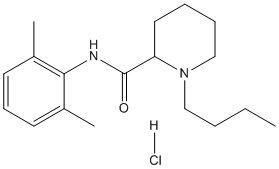All AbMole products are for research use only, cannot be used for human consumption.

Bupivacaine hydrochloride is a NMDA receptor inhibitor.Bupivacaine can block sodium, L-calcium, and potassium channels.Bupivacaine potently blocks SCN5A channels with the IC50 of 69.5 μM. Bupivacaine hydrochloride can be used for the research of chronic pain. Bupivacaine hydrochloride reversibly inhibits the SK2 channel in a dose-dependent manner with the IC 50 of 16.5 µM.
| Molecular Weight | 324.89 |
| Formula | C18H28N2O.HCl |
| CAS Number | 18010-40-7 |
| Solubility (25°C) | DMSO 25 mg/mL Water 12 mg/mL |
| Storage | 2-8°C, dry, sealed, protect from light |
| Related Animal experimental anesthetics Products |
|---|
| Orthocaine
Orthocaine is a local anesthetic agent. |
| Tolycaine
Tolycaine is an amide local anaesthetic. Tolycaine exhibits good anesthetic effects on mice. |
| Etidocaine hydrochloride
Etidocaine hydrochloride is an amino acidamide that acts as a local anesthetic with fast onset and long-acting properties. |
| Lidocaine N-ethyl bromide
Lidocaine N-ethyl bromide is a blocker of non-membrane-permeable,and Inhibits Acid-Induced Activation of Esophageal Nociceptive C Fiber Neurons. |
| MS-222
Tricaine methanesulfonate (MS-222) is common used to immobilize fish for marking or transport and to suppress sensory systems during invasive procedures. |
All AbMole products are for research use only, cannot be used for human consumption or veterinary use. We do not provide products or services to individuals. Please comply with the intended use and do not use AbMole products for any other purpose.


Products are for research use only. Not for human use. We do not sell to patients.
© Copyright 2010-2024 AbMole BioScience. All Rights Reserved.
